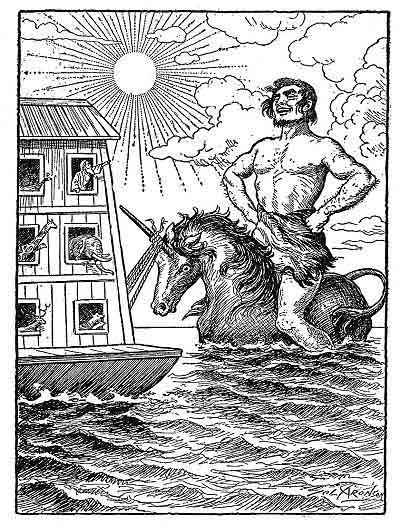Our world, according to the Jewish tradition, is filled with monsters, magic, and mayhem. While it’s easy to take to a rationalist position and explain it all away (see, for example, Natan Slifkin’s wonderful “Sacred Monsters” (1)), these non-rational ideas are so intertwined with our sacred texts, rabbinic tradition, religious rituals, and folk history that we lose something vital when we ignore them. What we lose, I feel, is the feeling that the world is more than what we see in front of us. There are depths not visible to the casual observer. And whether you engage those depths through reaching for deeper spiritual understanding, a deeper mystical understanding, a deeper ethical understanding or, in my case, a deeper supernal (celestial) understanding… reaching for these depths matter. And so, I’m training as an apprentice Jewish monster hunter and learning how to work in a world filled angels (including fallen angels), demons, dybbuks, golems, ghosts, and a wide array of critters.
There’s no better place to start writing about my Jewish monster hunter apprenticeship than last week’s parsha, Noah (2). Noah is a moment of crisis in Genesis where the old world, the more mythic world of creation, is literally washed away and, reading between the lines (as our tradition loves to do), there is a scramble for who, and what, will survive.
Humans survive, for sure. Noah, and his family, build and board the ark. And all living things board the ark too. Living things = animals, right? Bobcats and raccoons. Platypi and ostriches. Naked mole rats and fruit bats. Draco lizards and axolotls. All the animals we know and a bunch that we’ve lost (sorry mastodons and dodos). According to our tradition, though, more survived than we’re generally (rationally) aware of. Here are four kinds of creature that survive the flood.
Demons! According to Rashi, the great medieval French rabbi and commentator, “even demons” (sheydim) board the ark. Rashi noted that the parsha Noah makes a distinction between “all flesh” and “all living beings” which clearly means that beings who were not flesh board too. Demons, and how to avoid and cope for them, are a major part of Jewish religious sources and folklore.
Monster Hunting Pro Tip
Geoffrey Dennis’ “Encyclopedia of Jewish Myth, Magic and Mysticism”(3) points to two monster hunting pro tips. First, according to Tractate Exodus Rabbah 32 (4), the best way to deal with demons is by doing mitzvot, which brings guardian angels to your defense. Second, according to tractate Pesachim 11oa (5), if you’re a bit behind on your mitzvot, “[You] should clasp [your] right thumb in the fingers of [your] left hand, and vice-versa, and say, “I and my fingers are three.” If [you] hears a voice [saying] “You and I are four,” [you] should respond “You and I are five” and so on, until the demon gets angry and leaves.
Fallen Angels! While not a common theme in the talmud and later writings, early Jewish writings talk extensively about fallen angels. Genesis 6:4, for example, describes the Nephalim as “the divine beings [who] mated with the human women (6).” According to The Book of The Watchers, part of the apocryphal Books of Enoch (250-200 BCE), it was the evil of the Nephalim and their children that needed to be wiped out by the great flood (7). While the Nephalim seem to have been wiped out, they live on through their children.
Giants! And who were the children of the Nephaim? Evil giants! These giants “…devoured all the toil of men, until men were unable to sustain them. And the giants turned against them in order to devour men.” (Book of the Watchers). While the great flood (might have) wiped out the Nephalim, it did not wipe out all of the giants. According to Pirkei d’Rabbi Eliezer (23:8) one giant, Og, survived. Og struck a deal with Noah who then fed and sheltered him. (8) Og, later the king of Bashan, would live a long life until he forgot his oath and was killed by Moses. Og’s children would form giant clans that ranged all across Canaan.

Og, the giant, riding a unicorn. (9)
Unicorns! The exact meaning of re’em רֵּ֣ים is not known. It is often translated as “ox” and interpreted as the great aurochs, or wild bulls, which recently went extinct (1627 CE). In the Jewish tradition, however, re’em were understood to be giant one horned animals, the size of mountains. Talmud tractate Zevachim 113b:7-9 (10) asks the question the obvious question “how did the reima remain [after the flood]? Given its large size, it clearly could not have fit into Noah’s ark.” One answer, from Rabbi Yannai is “They brought reima cubs into the ark, and they survived the flood.” Another answer, from Rabbi Yoḥanan is “They brought only the head of the cub into the ark, while its body remained outside.” Hence, as shown in the illustration from “Aunt Naomi’s Jewish Fairy Tales and Legends (9)” Og the Giant could ride the mountain sized unicorn through the flood, as we might ride a horse across a flooded river
References:
(1) Sacred Monsters, Natan Slifkin. The best book on monsters in the Torah, written by a rationalist seeking to explain them all away. https://www.biblicalnaturalhistory.org/product/sacred-monsters/
(2) Parsha Noah. https://www.chabad.org/parshah/torahreading_cdo/aid/2473477/showrashi/true/jewish/Noach-Torah-Reading.htm
(3) The Encyclopedia of Jewish Myth, Magic and Mysticism: Second Edition (2016), Geoffrey Dennis. https://www.llewellyn.com/product.php?ean=9780738745916
(4) Exodus Rabbah 32:6. Talmud tractate. https://www.sefaria.org/sheets/115077.2?lang=bi&p2=&lang2=bi
(5) Pesachim 110a. Talmud tractate. https://www.sefaria.org/Pesachim.110a?lang=en
(6) Genesis 6:4. This is a very contemporary translations. Earlier translations typically referred to “sons of God” https://reformjudaism.org/learning/torah-study/breishit/english-translation
(7) Books of Enoch. A 1917 translation by R.H. Charles can be found online at https://www.sacred-texts.com/bib/boe/index.htm, though James Charlesworth’s “The Old Testament Pseudepigrapha” is the currently definitive translation.
(8) Pirkei d’Rabbi Eliezer 23:8. Pirkei d’Rabbi Eliezer is an aggadic-midrashic work dating to c.630 – c.1030 CE. https://www.sefaria.org/Pirkei_DeRabbi_Eliezer?lang=en
(9) Jewish Fairy Tales and Legends, by Aunt Naomi (pseud. Gertrude Landa),[1919]
https://www.sacred-texts.com/jud/jftl/index.htm
(10) Zevachim 113b:7-9 (7) Talmud tractate. https://www.sefaria.org/Zevachim?lang=en